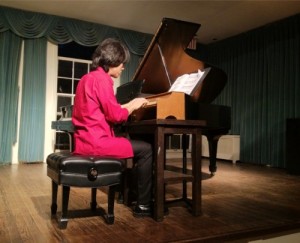Acclaim
Review
INEVITABLE LOGICS

“We two alone will sing like birds i' the cage” said Shakespeare’s Fool to Lear. Taka Kigawa last night made the singing come from a different kind of Cage, but with the same lyrical song. How difficult to say that John Cage piano music should “sing.” But Mr. Kigawa, that extraordinary pianist who, like the Koh-I-Noor Diamond, shows up in rare places and radiates all that he touches, did make the music perhaps not very challenging.
Specifically, he opened the recital with three pieces of very early Cage music. Nobody in the charming Greenwich Music School auditorium had to worry about Music of Changes or I Ching indeterminancy. Instead, the first pieces emanated whiffs of Satie, a faraway aroma of Japan, and a sumptuous meal of Claude Debussy. Dream was like an endless ostinato, frequently departing form its subject but with the same dreamy aura. Two other Schumannesque titles, Quest and In a Landscape, varied in tempo, but had that same Parisian feel, part improvisation, part pure melody with assorted loud chords, pegging our locations. These were played on a normal piano. Since Mr. Kigawa had gone to the trouble of fixing a prepared piano as well, I wish he had played more on that instrument. Those pings, thuds, muffled bangs and echoes, are endlessly delightful. Mr. Kigawa had only a single work, And the Earth Shall Bear Again, theoretically more violent, relatively more frenetic in its rhythms. Mr. Kigawa eschewed the violence, and played it–believe me!!– with a syncopated boogie-woogie flavor. I’m afraid Cage may have been listening more to Tommy Dorsey than Blind Lemon Jefferson, but the music was still charming, and, under Mr. Kigawa’s fingers, most surprising.
Mr. Kagawa’s performance of the Toy Piano Suite was played seriously (as it should have been), for this is not written for children. Like Stravinsky’s Five Fingers, the simplicity is deceiving. Most striking were the three different sounds from the tinhy instrument. First the tinkly musical line on the piano. Then the sounds of the wooden clappers on the keys. Third the resonances of the piano, each note echoing onto the other one. It was a prime example of Cage’s notion that every sound is music. (That isn’t my notion. Try choosing between a nightingale reverberating and a Harley revving. But I digress.) That Suite was orchestrated–for very large orchestra–by Lou Harrison, transforming the music with Brucknerian seriousness. A delicious jape. These works could have been called “Elementary Cage”. But not true. They all came from the same fecund inspiration, an inspiration less influenced by the later influence of Dr. Suzuki’s philosophy at Columbia University, and more by sheer music.
Not true for four (of 32) extraordinary Etudes Australes. A shame that the copies of the score weren’t passed out to this most sophisticated audience. Two staves for each hand (and no cheating!). No bar lines, choices of holding down notes as long as possible beyond the succeeding short notes, and complexities which can only be indicated, not written down. Next to the other works on the program, this was dangerous music, yet serious music as well. If we didn’t know the inner workings, Mr. Kagawa made the sound patterns and explosive piano and forte changes into an eccentric necklace, its irregular pendants suspended and aimless, glowing, twinging, jigging, dead and resurrected, all within micro-seconds of each other. Mr. Kigawa played each Etude not only with intensity, but giving an unavoidable quantum logic to every successive note.